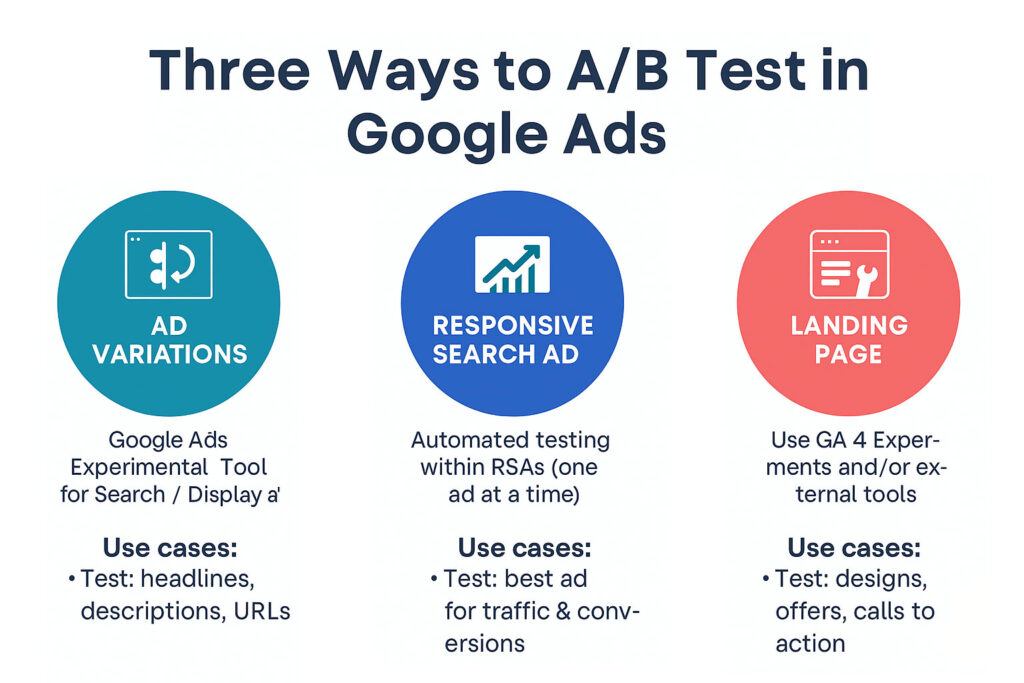Running Google Ads without testing is like flying blind. If you’re not A/B testing your ads, you’re not optimizing — you’re just guessing.
In this guide, we’ll show you how to set up, run, and interpret A/B tests in Google Ads — using proven methods that lead to higher click-through rates (CTR), better quality scores, and lower cost per conversion.
What Is A/B Testing in Google Ads?
A/B testing, also known as split testing, involves running two or more versions of a specific element in your ad campaign — such as a headline, description, call to action (CTA), or landing page — to determine which version performs better.
The goal is to make data-driven decisions that lead to better outcomes.
Common test elements include:
- Responsive Search Ad (RSA) headlines and descriptions
- Call-to-action phrasing (e.g., “Book Today” vs. “Get a Free Quote”)
- Destination URLs (different landing pages)
- Offer framing (“20% off” vs. “Free Shipping”)
- Display URLs and sitelinks

Why A/B Testing Matters
A/B testing is critical for campaign optimization because it allows you to:
- Increase click-through and conversion rates by improving relevance and clarity
- Eliminate underperforming creative or offers
- Improve Google Ads Quality Score, which reduces your cost per click
- Replace intuition and guesswork with measurable results
Even subtle changes — like replacing “Free Consultation” with “Book Your Appointment” — can yield significant performance differences.
Method 1: Using Google Ads Ad Variations Tool
Google Ads provides a built-in feature under the “Experiments” section called Ad Variations. This tool lets you test creative changes across multiple campaigns or ad groups.
How to use Ad Variations:
- Navigate to the “Experiments” section in the left-hand menu
- Click on “+ New Ad Variation”
- Choose the scope: account-wide, campaign-specific, or ad group level
- Select your test condition (for example, replacing Headline 2 with a new variation)
- Set the test split (usually 50/50) and duration
- Monitor the performance metrics in the variation dashboard
You can test elements like:
- Headline and description text
- Different messaging tones or structures
- CTA language
- Pinned versus unpinned assets
The Ad Variations tool ensures both versions receive similar visibility, making comparison more reliable.
Method 2: Testing Within a Single RSA
If you are using Responsive Search Ads, you can run informal A/B tests within a single ad by using asset-level reporting and pinning mechanics.
To run a comparison:
- Pin one headline variation to a specific position (such as position 1 or 2)
- Allow the rest of the headlines to rotate
- Use Google Ads asset reporting to monitor the performance rating of each element (e.g., “Low”, “Good”, “Best”)
While this is not a true 50/50 split, it can provide directional insight on which messaging elements work best.
Use this method to test:
- Brand-first vs. benefit-first messaging
- Different levels of urgency in CTAs
- Emotional versus rational appeals
Important: Because RSAs rely on machine learning to mix and match combinations, isolating test variables becomes harder. Use pinning sparingly to preserve ad strength.
Method 3: A/B Testing Final URLs (Landing Pages)
Landing pages can significantly impact conversion rates, and testing them is crucial for full-funnel optimization.
Steps to test landing pages:
- Duplicate your ad and assign different final URLs to each variation
- Make sure both landing pages are functional, fast, and track conversions
- Use either manual rotation (by duplicating ads) or Google Ads Campaign Experiments for controlled traffic splits
You can test:
- Form layout and length
- Call-to-action button design or color
- Visual emphasis (e.g., images vs. videos)
- Page copy hierarchy
- Desktop vs. mobile UX
Tools like Google Optimize, VWO, or Unbounce can help you quickly build and test landing page variations.
Best Practices for A/B Testing in Google Ads
1. Test one variable at a time
Testing multiple changes in one variation can muddy the results. Focus on one clear change per test cycle.
2. Ensure statistically significant data
Allow each variation to accumulate enough impressions (at least 1,000) or conversions (30 or more) before drawing conclusions.
3. Segment by funnel stage
Test different creative for cold traffic vs. remarketing users. Intent levels affect response to offers and CTAs.
4. Avoid seasonal or schedule bias
Make sure both versions run at the same time of day, across the same days of the week, to ensure fair testing.
5. Don’t rely only on click-through rate
While CTR is useful, your real success indicators are cost per conversion (CPA), conversion rate, and ROAS.
What You Can (and Should) Test
To guide your testing, here is a list of effective variables:
| Element | What to Test |
|---|---|
| Headline 1 | Branded vs. non-branded messaging |
| Headline 2 | Call to action variations |
| Headline 3 | Scarcity or urgency cues |
| Descriptions | Feature-focused vs. outcome-driven language |
| Display URL | Slug variation (e.g., /pricing vs. /plans) |
| Final URL | Entirely different landing pages |
| Sitelinks | Alternate labels or destinations |
| Callouts/Extensions | Highlight price vs. guarantee, reviews, etc. |
Interpreting Results
After your test has run long enough:
- Identify which variation produced better performance, based on your chosen metric (CPA, ROAS, CVR)
- Pause or retire the losing version
- Scale the winning variant and use it as your control in the next round of testing
- Keep a testing log to record what elements and language consistently win
Remember: testing is iterative. What works today may not work next month. Build a culture of constant experimentation.
Final Thoughts: A/B Testing Isn’t Optional – It’s Foundational
In competitive PPC environments, A/B testing is not a bonus tactic — it’s a core discipline. Whether you’re managing a modest monthly budget or scaling enterprise-level campaigns, testing ensures your ads adapt to changing user behavior, stay relevant, and continue to improve over time.
Structured experimentation drives insights.
Insights drive better decisions.
And better decisions drive real, measurable growth.
Work with 3MY: Structured Testing, Proven Impact
At 3MY, we don’t treat A/B testing as an afterthought. It’s built into every Google Ads strategy we deploy.
Our testing framework includes:
- Strategic variant planning based on funnel stages
- Rotational ad schedules and controlled distribution
- Responsive Search Ad optimization with asset-level analysis
- Full-funnel Campaign Experiments with proper attribution
We test deliberately. We optimize continuously. We scale what performs.
[Book your Free Strategy Session →]
Let’s move your account from intuition to precision — and from spend to return.










